Planning a trip to Italy? Uncover the true cost of an Italian adventure with TRAVELS.EDU.VN! Get ready to explore budgeting tips, average expenses, and insider advice for an unforgettable journey. Discover how to manage your travel expenses while experiencing Italy’s rich culture, delicious cuisine, and breathtaking landscapes. Find the perfect balance between budget and enjoyment.
1. Understanding the Costs: Italy Travel Overview
Italy, a land of ancient history, stunning landscapes, and delectable cuisine, is a dream destination for many. But how much does it really cost to travel to Italy? Planning your budget is a critical step to ensure you can fully enjoy your Italian adventure without any financial surprises. TRAVELS.EDU.VN is here to provide a comprehensive guide to help you estimate and manage your expenses effectively. With careful planning and smart choices, you can experience the best of Italy without breaking the bank. Knowing the average cost of a trip to Italy, including lodging, transportation, and food, will allow you to tailor your itinerary to your budget.
1.1. Defining Your Travel Style
Before diving into the numbers, it’s essential to define your travel style. Are you a budget traveler, looking for affordable accommodations and cheap eats? Or do you prefer luxury travel, with high-end hotels, fine dining, and private tours? Your travel style significantly impacts the overall cost. Consider these factors:
- Accommodation Preferences: Hostels, budget hotels, mid-range hotels, luxury hotels, Airbnb, or villas.
- Dining Choices: Street food, local trattorias, Michelin-starred restaurants, or self-catering.
- Transportation Options: Public transport, rental cars, taxis, or private transfers.
- Activities and Tours: Free attractions, budget-friendly tours, or private, exclusive experiences.
- Travel Season: Peak season (summer), shoulder season (spring/fall), or off-season (winter).
1.2. Key Cost Factors for an Italy Trip
Several factors influence the cost of traveling to Italy. Understanding these will help you tailor your budget accordingly.
- Flights: Airfare can be a significant expense, especially during peak season. Booking in advance and being flexible with your travel dates can help you find better deals.
- Accommodation: Hotel prices vary widely depending on the location, star rating, and time of year. Consider alternative options like Airbnb or agriturismos for potential savings.
- Transportation: Italy has an efficient train system, but renting a car may be necessary for exploring the countryside. Factor in the cost of gas, tolls, and parking.
- Food and Drink: Eating out can be expensive, especially in touristy areas. Opt for local eateries and consider cooking some meals yourself to save money.
- Activities and Entrance Fees: Many attractions charge entrance fees, and tours can add up quickly. Look for free activities and consider purchasing a city pass for discounts.
- Travel Insurance: While it adds to your initial cost, travel insurance is crucial for unexpected events like medical emergencies or trip cancellations.
- Personal Spending: Allow for souvenirs, shopping, and any unexpected expenses that may arise during your trip.
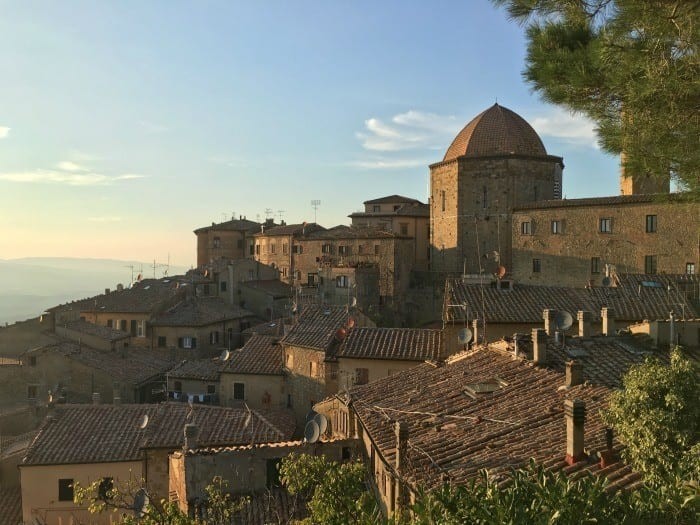 Volterra walls
Volterra walls
2. Detailed Breakdown of Italy Travel Costs
Let’s break down the average costs associated with a trip to Italy, providing you with a clearer picture of what to expect. These estimates are based on a mid-range travel style, balancing comfort and affordability.
2.1. Flights: Getting to Italy
- Average Round-Trip Airfare: $800 – $1,500 (depending on origin, season, and booking time)
Flights are a significant part of your budget, and prices vary depending on where you’re flying from and when you’re traveling. Summer (June-August) and holidays are the most expensive times to fly.
Tips for Finding Affordable Flights:
- Book in Advance: Aim to book 2-3 months before your travel date for the best deals.
- Be Flexible with Dates: Flying mid-week or during the shoulder season (April-May, September-October) can save you money.
- Use Flight Comparison Websites: Sites like Google Flights, Skyscanner, and Kayak can help you compare prices from different airlines.
- Consider Budget Airlines: Look into budget airlines that fly to Europe, but be aware of extra fees for baggage and seat selection.
- Accumulate Travel Points: Earning travel points through credit card spending and sign-up bonuses can significantly reduce or eliminate airfare costs. The Travel Freely app is an excellent resource for tracking credit cards and maximizing point accumulation.
2.2. Accommodation: Where to Stay in Italy
Accommodation costs vary greatly depending on the type of lodging and location. Here’s a general breakdown:
| Type of Accommodation | Average Cost per Night | Notes |
|---|---|---|
| Hostels | $30 – $50 | Budget-friendly option, ideal for solo travelers. |
| Budget Hotels | $70 – $120 | Basic amenities, often located outside city centers. |
| Mid-Range Hotels | $150 – $300 | Comfortable rooms, central locations, and additional amenities. |
| Luxury Hotels | $350+ | High-end amenities, excellent service, and prime locations. |
| Airbnb | $80 – $250 | Offers more space and often includes a kitchen, ideal for families or groups. |
| Agriturismos (Farm Stays) | $100 – $250 | Authentic experience in the countryside, often includes meals. |
Tips for Saving on Accommodation:
- Travel in the Off-Season: Hotel rates are significantly lower during the winter months.
- Consider Staying Outside City Centers: Accommodation tends to be cheaper in the suburbs, and you can easily commute to the city center by public transport.
- Look for Deals and Discounts: Websites like Booking.com, Expedia, and Hotels.com often offer discounts and loyalty programs.
- Explore Agriturismos: These farm stays offer a unique and often more affordable alternative to traditional hotels, especially in regions like Tuscany.
- Book accommodations at least six to nine months in advance: This is especially important if travelling in the high season to ensure the best selection and rates.
2.3. Transportation: Getting Around Italy
Italy offers a variety of transportation options, each with its own cost considerations.
| Type of Transport | Average Cost | Notes |
|---|---|---|
| Train | $20 – $100+ | Efficient and convenient for traveling between major cities. Prices vary depending on distance and class. |
| Rental Car | $30 – $70 per day | Ideal for exploring the countryside, but factor in gas, tolls, and parking fees. |
| Public Transport | $1.50 – $2 per ride | Affordable for getting around cities, consider purchasing a day or multi-day pass. |
| Taxis | $15 – $30 per ride | Convenient but expensive, especially in larger cities. |
Tips for Saving on Transportation:
- Utilize Public Transport: Make the most of Italy’s extensive train and bus networks to travel between cities and within urban areas.
- Book Train Tickets in Advance: High-speed train tickets can be cheaper if booked online ahead of time.
- Consider a Rail Pass: If you plan to do a lot of train travel, a rail pass may be a cost-effective option.
- Rent a Car Wisely: Only rent a car if you plan to explore rural areas. In cities, parking can be difficult and expensive.
- Walk or Bike: Many Italian cities are pedestrian-friendly, and renting a bike can be a fun and affordable way to explore.
- Car Rentals: Booking early with Auto Europe helps secure the best rates, especially for automatic transmissions, which are more expensive due to limited availability. Consider the car size to balance comfort and manageability on narrow roads. Arriving on Saturday morning, picking up a rental at the airport, and driving directly to Tuscany is a practical approach to avoid driving in Rome.
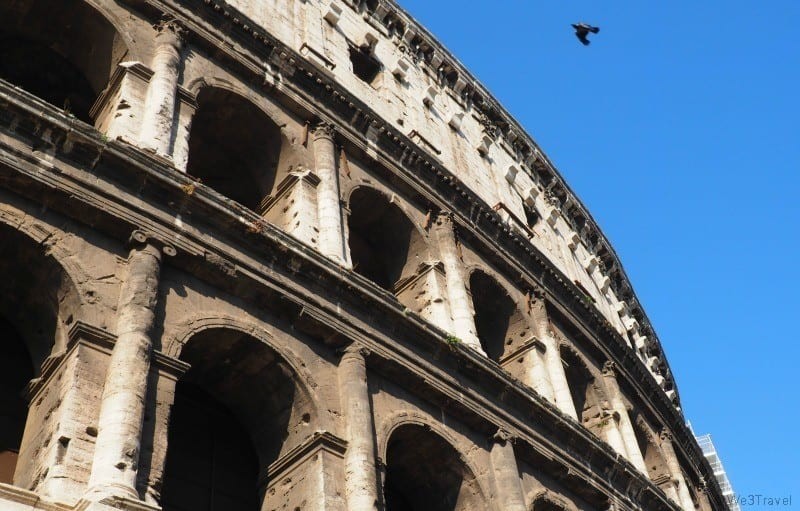 Colosseum
Colosseum
2.4. Food and Drink: Savoring Italian Cuisine
Food is an integral part of the Italian experience, but dining out can be a significant expense.
| Type of Meal | Average Cost | Notes |
|---|---|---|
| Street Food/Snacks | $5 – $15 | Pizza, panini, gelato – affordable and delicious options. |
| Casual Trattoria | $20 – $40 | Pasta, pizza, and other traditional dishes. |
| Mid-Range Restaurant | $40 – $70 | More upscale dining experience with a wider variety of dishes. |
| Fine Dining Restaurant | $80+ | High-end cuisine, impeccable service, and elegant ambiance. |
| Drinks (Coffee, Wine) | $2 – $10 | Prices vary depending on the location and type of drink. |
| Groceries | Variable | Purchasing groceries to cook your own meals can save money, especially for families or groups. |
Tips for Saving on Food and Drink:
- Eat Like a Local: Avoid touristy areas and look for local trattorias and osterias, which offer more affordable and authentic cuisine.
- Take Advantage of Aperitivo: Many bars offer free snacks with drinks during aperitivo hour (usually from 6 PM to 8 PM).
- Enjoy Pizza and Panini: These are affordable and filling options for lunch or a quick dinner.
- Cook Your Own Meals: If you have access to a kitchen, consider cooking some meals yourself, especially breakfast and lunch.
- Drink Tap Water: Tap water is generally safe to drink in Italy, so bring a refillable water bottle to avoid buying bottled water.
- Coffee Culture: Ordering coffee and pastry at the bar inside will be cheaper than table service outside.
2.5. Activities and Entrance Fees: Experiencing Italy’s Culture
Italy is rich in culture and history, with countless attractions and activities to enjoy.
| Type of Activity | Average Cost | Notes |
|---|---|---|
| Museums/Galleries | $15 – $30 | Entrance fees to popular museums like the Uffizi Gallery and the Vatican Museums. |
| Historical Sites | $5 – $20 | Entrance fees to sites like the Colosseum, Roman Forum, and Pompeii. |
| Guided Tours | $30 – $100+ | Walking tours, food tours, and private tours offer in-depth experiences. |
| Cooking Classes | $70 – $150+ | Learn to make traditional Italian dishes. |
| Wine Tasting Tours | $50 – $120+ | Explore the vineyards of Tuscany or other wine regions. |
| Free Activities | Free | Many churches, parks, and public squares are free to enter and explore. |
Tips for Saving on Activities:
- Take Advantage of Free Activities: Explore parks, churches, and public squares, which are often free.
- Look for City Passes: Many cities offer passes that include entrance to multiple attractions at a discounted price.
- Book Tours in Advance: Booking tours online can often save you money compared to booking on the spot.
- Consider Free Walking Tours: Many cities offer free walking tours, where you tip the guide based on your satisfaction.
- Visit During Free Admission Days: Some museums offer free admission on certain days of the month.
- Tours: Private tours are highly recommended for families travelling with kids and for unique ways to explore cities, but small group tours offered by companies like LivTours and Walks of Italy offer better value.
2.6. Souvenirs and Miscellaneous Expenses
Allowing for souvenirs and miscellaneous expenses is crucial for a realistic budget.
- Souvenirs: $50 – $200+ (depending on your shopping habits)
- Tips: $10 – $30 per day (for tour guides, waiters, and other service staff)
- Travel Insurance: $50 – $150 (depending on coverage and duration)
- Unexpected Expenses: $100 – $300 (for emergencies, medical expenses, or spontaneous activities)
Tips for Saving on Souvenirs:
- Shop at Local Markets: Markets often offer unique and affordable souvenirs compared to tourist shops.
- Buy Edible Souvenirs: Local food products like olive oil, wine, and spices make great gifts.
- Look for Sales and Discounts: Keep an eye out for sales and discounts at local stores.
- Set a Budget: Decide how much you’re willing to spend on souvenirs before you start shopping.
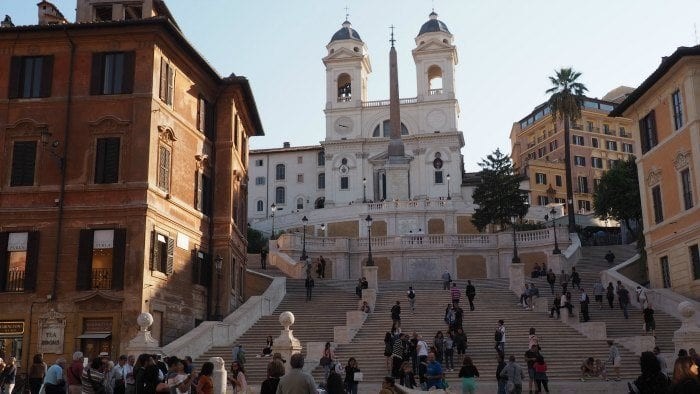 Spanish Steps in Rome
Spanish Steps in Rome
3. Sample Italy Trip Budgets
To give you a better idea of how the costs can vary, here are three sample budgets for a 10-day trip to Italy for one person:
3.1. Budget Traveler: $1,500 – $2,500
- Flights: $800
- Accommodation: $30 – $50 per night (hostels, budget hotels) = $300 – $500
- Transportation: $150 (public transport, occasional train)
- Food and Drink: $30 per day (street food, casual eateries, cooking some meals) = $300
- Activities: $100 (free activities, a few low-cost attractions)
- Miscellaneous: $150
3.2. Mid-Range Traveler: $3,000 – $5,000
- Flights: $1,000
- Accommodation: $150 – $250 per night (mid-range hotels, Airbnb) = $1,500 – $2,500
- Transportation: $300 (trains, public transport, occasional taxi)
- Food and Drink: $60 per day (trattorias, some restaurants) = $600
- Activities: $400 (museums, guided tours)
- Miscellaneous: $300
3.3. Luxury Traveler: $7,000+
- Flights: $1,500+
- Accommodation: $350+ per night (luxury hotels) = $3,500+
- Transportation: $500+ (private transfers, taxis)
- Food and Drink: $100+ per day (fine dining restaurants) = $1,000+
- Activities: $1,000+ (private tours, exclusive experiences)
- Miscellaneous: $500+
4. Tips for Saving Money on Your Italy Trip
No matter your travel style, there are always ways to save money on your Italy trip.
- Travel in the Shoulder Season: Spring (April-May) and fall (September-October) offer pleasant weather and lower prices.
- Consider Alternative Destinations: Explore lesser-known regions like Umbria or Le Marche, which offer similar experiences to Tuscany at a lower cost.
- Take Advantage of Free Activities: Many cities offer free walking tours, and there are plenty of parks, churches, and public squares to explore.
- Eat Like a Local: Avoid touristy areas and look for local trattorias and osterias, which offer more affordable and authentic cuisine.
- Cook Your Own Meals: If you have access to a kitchen, consider cooking some meals yourself, especially breakfast and lunch.
- Utilize Public Transport: Make the most of Italy’s extensive train and bus networks to travel between cities and within urban areas.
- Book in Advance: Booking flights, accommodation, and tours in advance can often save you money.
- Be Flexible: Being flexible with your travel dates and destinations can help you find better deals.
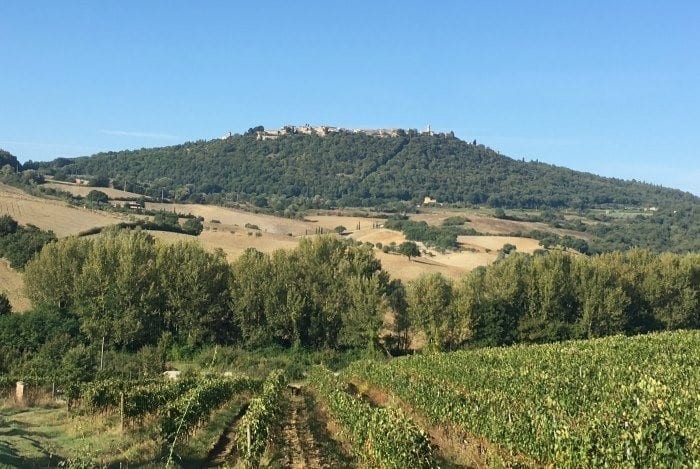 Montefollonico in Tuscany
Montefollonico in Tuscany
5. Planning a Family Trip to Italy: Budget Considerations
Traveling to Italy with a family requires careful budgeting to ensure a comfortable and enjoyable experience for everyone. This section focuses on a family of four (two adults and two children aged 6-11) traveling during the summer months.
5.1. Assumptions for a Family Budget
- Travel Style: Comfortable with three to four-star accommodations, balancing budget and enjoyment.
- Duration: 12-day trip, with four nights in Rome and one week in Tuscany.
- Travel Season: Summer months (June-August), the most expensive time to visit.
5.2. Key Budget Elements for Families
- Airfare: $5,200 (approximately $1,300 per person)
- Accommodation: $8,200 ($4,800 for Rome, $3,400 for Tuscany)
- Transportation: $600 (car rental for Tuscany, airport transfers)
- Tours and Activities: $2,750 (private tours in Rome and Florence, skip-the-line tickets)
- Food: $2,040 (mix of restaurants and self-catering)
- Souvenirs & Miscellaneous: $500
- Travel Insurance: $700
5.3. Detailed Family Budget Breakdown
5.3.1. Airfare
Summer airfare can be expensive, averaging around $1,300 per person for direct flights. Booking six months in advance or using travel points can help reduce costs. Services like Going can alert you to sales on destinations you’re watching.
5.3.2. Accommodation
Finding accommodations for a family of four can be challenging, often requiring two hotel rooms or a pricey suite. In Rome, a four-star hotel can cost around $600 per night per room in the city center. VRBO apartments offer an alternative, with options like a three-bedroom apartment with a view of the Colosseum for $350 per night.
In Tuscany, options range from luxurious resorts like Belmond’s Castello di Casole ($3,000 per night) to budget-friendly agriturismos. Agriturismos offer self-catering apartments on working farms, often with a shared pool. Al Gelso Bianco, for example, offers a two-bedroom apartment for $3,400 per week during high season.
5.3.3. Transportation
A car is essential for exploring Tuscany. Auto Europe can help find the best rental rates. Booking early is recommended, especially for automatic transmissions. A week-long rental of an automatic station wagon can cost between $400 and $1,000. Avoid driving in Rome by picking up the rental car at FCO airport upon arrival and dropping it off before departing from Rome. Car services like Welcome Pickups offer convenient airport transfers for around $65-$80.
5.3.4. Tours and Activities
Private tours are highly recommended when traveling with kids. They typically cost around $500 for a family of four. In Rome, consider tours of the Colosseum, Roman Forum, Vatican Museums, and Borghese Gallery. In Tuscany, day trips to towns like Lucca, Pisa, and Siena are popular. Consider a family-friendly wine or food tour with companies like Tuscan Organic Tours.
5.3.5. Food
Food costs can vary. Staying away from touristy areas can lead to more affordable options. Trattorias and osterias are less formal and less expensive than restaurants. Budget around $170 per day for a family, which allows for flexibility with pizza and pasta. Agriturismos often provide access to a kitchen, allowing for self-catering.
5.3.6. Souvenirs & Miscellaneous Expenses
Allocate a budget for souvenirs, which can include wooden toys, leather goods, and local products like wine and olive oil. Also, include tips for tour guides and other service staff. A general rule of thumb is $50 per day.
5.3.7. Travel Insurance
Travel insurance is essential to protect your trip. Budget between $600 and $1,000 for a family, as pricing varies depending on coverage and ages.
5.4. Average Total Family Trip Cost
Based on these estimates, a 12-day trip to Italy for a family of four during the summer months will cost approximately $19,990, or $416 per person per day.
Total Family Trip to Italy Cost: $19,990
| Category | Expense |
|---|---|
| Airfare | $5,200 |
| Accommodations | $8,200 |
| Transportation | $600 |
| Tours & Activities | $2,750 |
| Food | $2,040 |
| Souvenirs & Misc. | $500 |
| Travel Insurance | $700 |
| Total Cost | $19,990 |
5.5. Tips for Saving on a Family Trip
- Use Points for Airfare: Redeem travel points to cover the cost of one or more plane tickets.
- Consider Budget Airlines: Look into budget airlines with connections in Europe to lower airfare costs.
- Stay in Vacation Rentals: Opt for apartments or agriturismos with kitchens to save on meals.
- Take Small Group Tours: Small group tours or self-guided explorations can be more budget-friendly than private tours.
- Cook Your Own Meals: Preparing some meals at your lodging can significantly reduce food expenses.
- Limit Extra Spending: Be mindful of unnecessary expenses and prioritize experiences over material items.
By following these tips and planning carefully, families can enjoy an unforgettable Italian vacation while staying within budget.
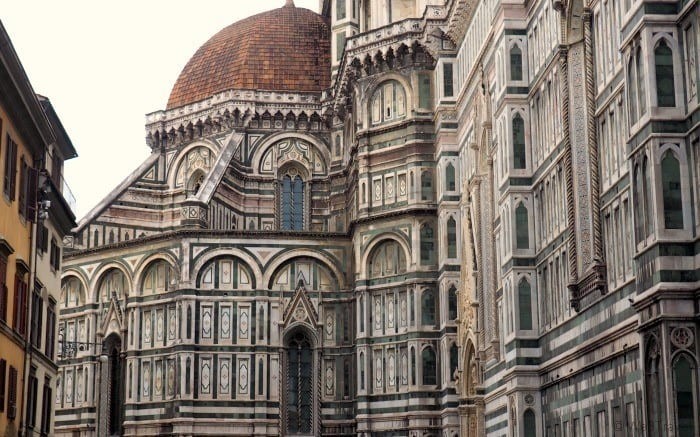 Duomo in Florence
Duomo in Florence
6. Why Choose TRAVELS.EDU.VN for Your Italy Trip Planning?
Planning a trip to Italy can be overwhelming, but TRAVELS.EDU.VN is here to make the process seamless and enjoyable. We offer a range of services designed to cater to your specific needs and preferences.
6.1. Personalized Itineraries
We understand that every traveler is unique. Our team of expert travel planners will work with you to create a personalized itinerary tailored to your interests, budget, and travel style.
6.2. Expert Advice
Benefit from our extensive knowledge of Italy. We provide insider tips on the best places to visit, eat, and stay, ensuring an authentic and unforgettable experience.
6.3. Cost-Effective Solutions
We help you find the best deals on flights, accommodation, and activities, ensuring you get the most value for your money. Our budget-friendly recommendations allow you to experience Italy without breaking the bank.
6.4. Stress-Free Planning
Let us handle the details. From booking flights and accommodation to arranging tours and transportation, we take care of everything so you can relax and enjoy your trip.
6.5. 24/7 Support
We’re here for you every step of the way. Our dedicated support team is available 24/7 to assist you with any questions or concerns.
7. Ready to Plan Your Dream Italy Trip with TRAVELS.EDU.VN?
Don’t let the complexities of planning an Italy trip hold you back. Contact TRAVELS.EDU.VN today, and let us help you create the perfect Italian adventure.
Contact Information:
- Address: 123 Main St, Napa, CA 94559, United States
- WhatsApp: +1 (707) 257-5400
- Website: TRAVELS.EDU.VN
Let TRAVELS.EDU.VN turn your Italian dream into a reality! Contact us today for a free consultation, and let’s start planning your unforgettable journey.
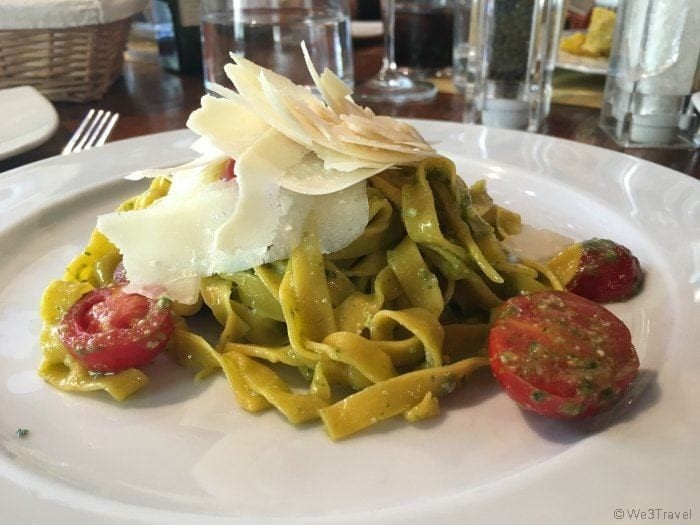 Pasta at La Bandita Townhouse in Pienza
Pasta at La Bandita Townhouse in Pienza
8. Frequently Asked Questions (FAQs)
Q1: How Much Does It Cost To Travel To Italy on a budget?
A: On a budget, you can expect to spend around $1,500 – $2,500 for a 10-day trip, including flights, hostels, street food, and free activities.
Q2: What is the average cost of a mid-range trip to Italy?
A: A mid-range trip to Italy costs approximately $3,000 – $5,000 for a 10-day trip, including flights, mid-range hotels, trains, restaurants, and guided tours.
Q3: How much should I budget for a luxury trip to Italy?
A: A luxury trip to Italy can cost upwards of $7,000 for a 10-day trip, including flights, luxury hotels, private transfers, fine dining, and exclusive experiences.
Q4: What are the best ways to save money on accommodation in Italy?
A: To save money on accommodation, consider traveling in the off-season, staying outside city centers, looking for deals and discounts, and exploring agriturismos.
Q5: How can I save money on transportation in Italy?
A: To save on transportation, utilize public transport, book train tickets in advance, consider a rail pass, rent a car wisely, and walk or bike.
Q6: What are some tips for saving money on food and drink in Italy?
A: To save on food and drink, eat like a local, take advantage of aperitivo, enjoy pizza and panini, cook your own meals, and drink tap water.
Q7: What are some free activities to do in Italy?
A: Free activities in Italy include exploring parks, churches, and public squares, visiting during free admission days, and taking advantage of free walking tours.
Q8: How much does it cost for a family of four to travel to Italy?
A: A 12-day trip to Italy for a family of four costs approximately $19,990, including flights, accommodation, transportation, tours, food, souvenirs, and travel insurance.
Q9: What is the best time to visit Italy for budget travelers?
A: The best time to visit Italy for budget travelers is during the shoulder season (April-May, September-October) or the off-season (November-March).
Q10: How can TRAVELS.EDU.VN help me plan my Italy trip?
A: TRAVELS.EDU.VN offers personalized itineraries, expert advice, cost-effective solutions, stress-free planning, and 24/7 support to help you create the perfect Italian adventure.
9. Conclusion
Planning a trip to Italy involves careful consideration of various costs, from flights and accommodation to transportation and activities. By understanding these expenses and utilizing the tips provided by TRAVELS.EDU.VN, you can create a budget that suits your travel style and preferences. Whether you’re a budget traveler or seeking a luxurious experience, Italy offers something for everyone. Contact travels.edu.vn today and let us help you plan your dream Italian adventure.